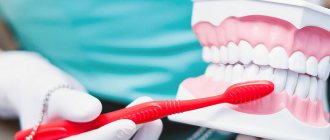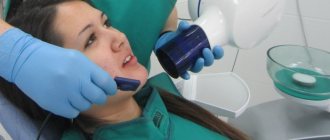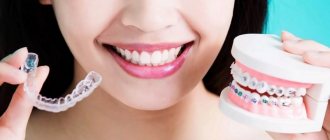Caries: features, symptoms
According to statistics, at least 95% of people in the world have encountered caries at least once. This is the most common dental disease that affects people regardless of gender, age and lifestyle.
Caries belongs to the list of pathological processes. Initially, it begins to destroy the enamel, but if left untreated, it also affects the deep hard layers of tooth tissue. When soft tissue inflammation begins, blood vessels and nerves are inevitably also affected.
Patients often wonder whether tooth decay needs to be treated. In fact, it is necessary not only to engage in prevention, but also to begin treatment as soon as possible. If the disease is neglected, there is a high risk of losing the tooth completely.
There are several categories of causes of caries in humans.
The answer to the question of how to treat dental caries depends on the cause of such a disease. It is also very important to eliminate potential conditions for the development of tooth decay.
There are several reasons that can stimulate the appearance of damage to enamel and soft tissues:
- Severe bacterial plaque. It occurs when a person does not properly care for his teeth. It is very important to maintain regular oral hygiene, brush your teeth properly, and use floss.
- Tartar. It can also form if the patient does not comply with the rules of oral hygiene. If the stone is not removed in a timely manner, the lesion will constantly progress and spread.
- Poor nutrition. Risk factors include consuming large amounts of sweet and sour foods. Also on the list of dangerous foods are foods high in carbohydrates and starch. When consuming a large amount of low-quality and unhealthy food, tooth enamel gradually begins to become thinner. Because of this, under the influence of bacteria, the risk of caries becomes increasingly noticeable.
- Decreased saliva production. Under normal conditions, a person produces up to two liters of saliva per day. It is necessary so that food debris can be washed off the surface of the tooth. When the salivary glands do not function properly, these residues remain and the risk of bacterial growth increases.
- Lack of minerals in food. The human body either does not produce many useful substances that are needed to strengthen bones and tooth enamel, or receives them in small quantities. The list of main substances that must be obtained from foods includes fluorine, calcium, and phosphorus. At the same time, genetics also leads to problems for some people. Some people are simply genetically predisposed to accumulate a minimum of nutrients.
- Pregnancy. At different stages, there is a possibility that the fetus takes a lot of useful substances from the mother. She begins to experience a severe lack of minerals.
- Diseases of the body. Patients with systemic pathologies that directly affect metabolic processes are also at risk. Particularly dangerous are variants of diseases such as lesions of the thyroid gland, peptic ulcers, diabetes mellitus, gastritis, and imbalance of hormones in the body.
Another factor in the development of caries is the poor environmental situation in a person’s place of residence. It can stimulate the development of caries, rapid damage to both hard and soft tissues.
For this reason, a high incidence of caries is observed in regions where there are a lot of acids, heavy metal salts, and alkali vapors scattered in the air.
In order to develop a treatment method in a certain situation, it is necessary to understand what reason for the development of the disease is relevant in the case of a particular patient.
The fact is that often it is chronic diseases, improper oral hygiene, and lack of nutrients that can trigger the recurrence of the disease. In any situation, it is very important to eliminate the cause itself.
How does dental caries occur?
At least once in their life, everyone has been to the dentist and had their teeth treated, but not many people know what dental caries is as a pathological process.
It develops when bacterial biofilm (plaque) converts sugars from carbohydrate foods into organic acids. The latter work as solvents of tooth enamel and dentin, consistently destroying the tooth structure. With a large amount of plaque, increased production of acids occurs, which leads to the rapid development of caries.
Thus, if a person consumes large quantities of carbohydrates for a long time, neglects brushing his teeth or does not remove plaque well, the body does not receive minerals in the required quantities, and the teeth are destroyed. First, a small focus of demineralization appears on the enamel, which looks like a light spot, then a cavity appears in the enamel layer. If the teeth are not cured at this stage of superficial caries, the destruction affects the dentin - it goes into the stage of first medium and then deep caries. The stronger and deeper the carious lesion, the more difficult and painful the treatment of caries will be, the greater the risk of complications, including tooth loss. Therefore, it is important to treat it immediately when the first symptoms appear.
Main types of caries
How caries is treated in dentistry largely depends on which type of spread is typical for a particular person. There are several classification criteria:
- Spread intensity. This category includes single and systemic caries. The difference is that in the first case, the patient is not diagnosed with any additional symptoms. In the second case, the entire row or most of it is also affected. The constant spread of new lesions not only stimulates damage to the enamel and soft tissues, but also impairs the functioning of the human immune system.
- Complexity of development. Uncomplicated caries is the easiest to treat. In this case, there are no additional disorders that lead to the need for additional surgical intervention. Complicated caries is a situation that is accompanied by periodontitis and pulpitis. In this case, treatment must be much longer and more difficult.
In our clinic, doctors treat caries regardless of the stage of the process. We are ready to deal with a problem when there is one of the following four stages:
- Spot. In this case, only the enamel is affected. At the same time, there are spots on the surface with a dark or pale tint. Some people develop stripes instead of spots that are a different color from the rest of the surface.
- Initial surface position. The spot begins to gradually grow, and a hole develops. Sensitivity also increases.
- Middle stage of caries. Dentin begins to deteriorate and pain worsens.
- Deep defeat. Active necrotic damage to hard and soft tissues begins, nerve endings and blood vessels are affected. Treatment in this case will be much more complex and lengthy.
There is also another classification factor - the location and depth of tooth damage. There are five main classes:
- First. It is characterized by damage to the enamel. At the same time, at the first stage it will be very difficult to understand whether there is a lesion, because visually caries shows little of itself.
- Second. Most often it appears on chewing molars, as well as premolars, regardless of the jaw.
- Third. Found on canines and incisors. Most often, the problem is due to the fact that a person eats a lot of sweets.
- Fourth. Characterized by significant destruction of enamel.
- Fifth. The most severe type of flow option. In this case, caries can affect the entire row of teeth, manifesting itself closer to the gums, near the root - where it is very difficult to cure.
Anesthesia in dentistry
Not so long ago, people associated dental treatment with pain. Today, to make this process more comfortable, anesthesia is used.
All types of anesthesia can be divided into several groups:
- Local. In this case, application, infiltration and conduction anesthesia are used. This is the most common type of anesthesia used in the treatment of dental canals, nerve removal, caries, pulpitis and other diseases;
- General or anesthesia. This type of anesthesia is used only for special indications and major operations;
- Combined. This type of pain relief is especially suitable for people with panic conditions. In this case, the patient is conscious, but does not experience any feelings, including fear.
Main signs of caries
Often, patients simply do not realize that they have tooth decay because they expect significant enamel damage, severe pain, or other common signs. But the best solution would be to contact our dentists in a timely manner for a thorough external examination.
There are several most common signs that a person is developing tooth decay:
- Change in enamel color. It can change color a lot. Stripes or dots of a dark or light shade appear. At this stage there may be no increased sensitivity or significant pain.
- Increased tooth sensitivity. It appears when eating hot and cold food, pressing, chewing, in the case of sweet or sour foods.
- Severe damage to the enamel. It is immediately noticeable by black holes in the teeth and partial destruction of the enamel.
- Pain. It can be of a different nature, either acute or long-lasting, aching. Depending on the type of problem, it either gets worse when pressing on the tooth or gets smaller.
- Bad breath. Occurs due to significant necrotic tissue damage.
Also, other manifestations are characteristic of the later stages of the disease - headaches, a feeling of shooting pain in the ears. For some, the inflammatory process stimulates fever, general weakness and decreased immunity.
Why does a tooth hurt after treatment and what to do in this case?
Aching pain after treatment occurs quite often. However, its causes may be different, which means that the doctor’s actions to eliminate it are required different. Let's look at the most popular:
- Very often, after treatment, the tooth reacts to mechanical stress when chewing food. As a rule, minor pain appears after treatment of deep caries. This is due to the fact that the filling puts pressure on the pulp. Over time, the pain will pass.
- It is not uncommon for a tooth to ache after treatment and due to an individual reaction to the doctor’s intervention. The pain may persist for several days.
- Acute pain after dental treatment cannot be ignored. You must immediately contact a specialist. Unpleasant pain may indicate that there is inflammation after dental treatment.
- If you are sensitive to irritants such as hot and cold drinks, sweet or sour foods, then there is a high probability that the overhanging edge of the filling will injure the periodontal tissue in the gum area. This phenomenon leads to tissue inflammation and exposure of the tooth root, which is extremely sensitive to any irritants. Therefore, be sure to contact the dental clinic if your tooth aches after recent manipulations. The treatment was most likely carried out poorly.
Potential consequences and complications
The very question of whether caries should be treated is very dangerous. It is important to never doubt that treatment is necessary. Often a person observes the first symptoms of a problem, but begins to put off going to the dentist. The time for treatment is constantly being delayed more and more.
The main danger of this approach is the likelihood of complications. The most common among them is the appearance of periodontitis or pulpitis.
There are several of the most serious consequences of untreated caries:
- Tooth loss. If the tooth is severely damaged or the lesion has gone very deep, there is nothing left except surgical intervention.
- Pathological processes in the gums. They can lead to the need to remove not only the affected tooth, but also its completely healthy neighbors.
- Systemic complications in the functioning of internal organs. The gastrointestinal tract and immune system suffer greatly. It is important to understand that a sluggish inflammatory process has a sharp negative effect on the entire body and weakens it.
The question of how caries is treated in dentistry in children is always considered separately. It is necessary to solve the problem that has arisen with baby teeth, because advanced disease leads to pathologies in the formation of permanent dentition.
Methods for diagnosing caries
In order to develop a program for the correct treatment of a patient with caries, it is very important for the doctor to make a correct diagnosis and find out what caused the damage to the tooth tissue.
The work uses two main methods:
- Visual inspection. The doctor uses a special instrument to check the condition of the tooth and whether there are signs of damage. A detailed examination helps to understand which tooth is affected, even if there are no clear external signs.
- Radiography. X-rays in our clinic are performed using high-quality modern equipment. This allows you to get a clear picture of the condition of the deep parts of the tooth, its roots. In this way, it is possible to understand exactly how severe the lesion has developed.
Also, at the first appointment, the doctor collects a general picture of the person’s condition and finds out what the cause of the disease may be. A good dentist always tries to eliminate not only the tissue damage itself, but also the factors leading to its appearance.
How long does it take to treat caries?
The duration of the treatment procedure may vary depending on the condition of the patient and how deep the tissue damage has gone.
Depending on the initial conditions, treatment can be carried out in one or two stages. In the first case, the process rarely takes more than half an hour. In the second case, this time is extended over two visits - you need to kill the nerve and only then carry out other manipulations.
Thanks to their extensive experience and level of professionalism, our dentists cope with the task with minimal time.
Modern dental treatment
Dental treatment of teeth is a set of measures aimed at eliminating the inflammatory process and restoring chewing functions. The most common disease is, of course, caries and its complications. The timing of dental treatment directly depends on the stage of development of the disease. Thus, installing a dental crown or implanting several teeth will take different times, depending on the number of specialist appointments. It is worth noting that regular preventive examinations allow you to notice pathologies at an early stage, allowing for dental treatment without extraction and significantly simplifying it.
If a patient comes to the clinic with acute pain, the task becomes much more complicated. Therefore, every dentist will tell you that the best dental treatment is prevention.
Photos before and after dental treatment
Photos Before and After treatment of chewing teeth.
Photos Before and After treatment of front teeth.
Basic methods of caries treatment
A specific method of caries treatment is selected depending on the stage of the disease and how severely the tooth tissue is affected.
Let's consider the treatment method using the example of deep caries. It is quite common due to the fact that the patient delays visiting the dentist’s office for as long as possible. Among the central stages are the following:
- Examination of the affected tooth to determine the current condition. The doctor takes an x-ray, which will clearly show the extent of the lesion. This will allow you to create a plan for subsequent treatment.
- Anesthesia. Allows you to work with affected tissues painlessly. Today, high-quality, harmless drugs are used that can be used even in the treatment of children and pregnant women.
- Tooth isolation. It is important that the tooth is protected from saliva accumulating in the mouth.
- Removal of dentin affected by caries. This can be done using different methods, either using a standard drill or a laser. The dentist needs to properly form the cavity and also clean the space well.
- Treatment with antiseptics. This eliminates tissue damage, because there are a lot of blood vessels in the soft tissues of the tooth.
- Drying. If saliva does get into the cavity, the drying process allows it to be completely removed. Also, the air flow blows out any remaining tooth dust that remains after drilling.
- Placement of a temporary filling. Before this, a special calcium pad is also placed. The practice of installing a special temporary filling is necessary in order to reduce the risk of pulpitis.
- Choosing a specific filling color. This is especially important if you need to fill the visible part of the tooth that opens when you smile. Our dentists use many options of materials that can be harmoniously matched to the shade of the enamel.
- Filling. We use high-quality, durable fillings. They are created without the use of harmful substances and are not deposited in the body over time.
The whole process ends with the filling being ground and ground down. The dentist also determines whether it is comfortable for a person to close his jaws, and whether there is a feeling that something is in the way.
The doctor also comes up with a list of measures to ensure protection from most potential dangers and factors that could negatively affect the health of the tooth.
If the damage to hard tissue is small, only the superficial layer is affected, other means can be used:
- Infiltration. Involves a combination of chemical and mechanical means for treatment. This allows you to remove a small spot of caries. This approach is common if a person has been wearing braces for a long time.
- Ozone therapy. The technique allows you to achieve high-quality remineralization, as well as eliminate harmful bacteria that multiply in the body. In this case, drilling is excluded, and anesthesia is not required.
- Processing by air-abrasive method. In this case, a special mixture of air and abrasive material directly affects the carious cavity. At the same time, providing additional protection helps prevent particles from getting on the mucous membranes.
- Laser treatment. Modern lasers do not allow tissue to warm up. Using this technique, even children and pregnant women can be treated.
Our dentists carefully check the patient's current condition in order to understand which remedy will be most effective and safe.
How to treat caries step by step
The algorithm is something like this:
- Plaque and dental deposits are removed from the surface of the diseased tooth and those adjacent to it. For this purpose, abrasive pastes, ultrasonic nozzles, and special brushes are used.
- The dentist selects a shade of filling material that is as close as possible to the natural color of the teeth. A special scale is used to select the tone.
- Anesthesia. Treating medium and deep caries without anesthesia is quite painful, so most patients are given local anesthesia - an anesthetic injection. The duration of its effect depends on the type and dosage of anesthesia.
- Preparation of a carious cavity. At this stage, the doctor drills out the affected tooth tissue, removing destroyed dentin and the edges of the enamel hanging over the cavity. If the dentist violates the technology and leaves at least part of the affected tissue under the filling, the patient will develop secondary caries, and if the crown is completely destroyed, pulpitis and periodontitis.
- Isolation of a diseased tooth. To properly fill a tooth, it must be dry. Therefore, dentists use a rubber dam (a special plate) to protect the tooth from saliva. The quality of insulation directly affects the service life of the seal.
- Treatment of the tooth cavity with antiseptics for thorough disinfection.
- Reconstruction of the side wall. If the carious lesion is located in the area between the teeth, the tooth wall must be restored before installing a filling.
- Acid etching and adhesive application. These manipulations are necessary in order to increase the adhesion of the cavity walls and the filling material and ensure reliable fixation of the filling.
- Installation of therapeutic or insulating pads. Therapeutic ones are given in the presence of inflammation; insulating ones are needed to prevent shrinkage of the filling and its negative effect on the tooth tissue.
- Filling. Today, photopolymer composites are used in most cases. They are applied layer by layer and illuminated with a lamp to harden the material. Photopolymer composites are good because they almost do not shrink, have high strength and reliability.
- Bite adjustment, grinding and polishing. The doctor adjusts the size and shape of the filling so that when it comes into contact with the teeth of the opposite row, the filling does not interfere, and the jaws can close normally. At the end of the procedure, the dentist grinds and polishes the surface, removing all unevenness and roughness and giving the filling an aesthetic appearance.
Thus, caries in adults can be treated in different ways. The choice of method depends on the stage of the disease, tolerance to anesthesia and a number of other factors. It is important to remember that the sooner you see a doctor, the simpler and faster the treatment will be.
How children are treated
Many patients think that baby teeth need not be treated. But this is a common misconception that can lead to serious problems.
If the caries of a baby tooth is not cured, there is a high probability that, as a result of the advanced disease, problems will arise with the change of the time series to the root one.
When treating a child, it is very important to fulfill several basic requirements at once:
- An individual approach to the child is important. Our clinic employs doctors who specialize in treating children. They know well how to calm a small patient and what to do so that he does not worry. This is important because it is in this case that it is possible to rid the child of fear of dentists in the future.
- Only specially selected anesthesia is used. It is important to use medications that are needed specifically for a child at a young age.
- Doctors always try to detect the disease at an early stage and do everything to cure it. This way, you can ensure that you do not have to use more traumatic methods for treatment.
Our dentists know well how to treat caries in baby teeth without pain and potential threats to the baby’s health.
Is it possible to treat teeth for pregnant women?
Many patients are interested in whether caries can be treated during pregnancy. There is a common misconception that using anesthesia is dangerous and poses a great risk to the health of both mother and child.
In fact, a lot of this depends on the state of the woman. In the later stages, it is best to avoid treatment, because severe stress can negatively affect the woman’s condition.
Otherwise, it is much better to cure your teeth than to put up with the potential consequences. For a woman, the consequences of untreated caries will be much more dangerous - a strong inflammatory process in the body, the potential introduction of infection into the blood.
Methods for preventing caries
Doctors note that many cases of caries can be avoided if a person pays close attention to his health. There are several basic tips that will help you protect your body:
- Try to balance your diet. You need to reduce the amount of foods high in carbohydrates, sugar and starch in your diet. Sugar also negatively affects the condition of teeth.
- Pay attention to the quality of oral hygiene. Be sure to brush your teeth regularly and at the same time observe the duration and method of brush movement. It is also recommended to pay attention to what kind of toothpaste you use, use irrigators, rinses, and dental floss.
- Visit your dentist regularly. Regular medical examinations are very important. In this case, it will be possible, if not completely protected, to get rid of most oral problems at an early stage.
Our doctors will conduct a thorough examination of the oral cavity and give additional recommendations on hygiene and caries prevention.
Advantages of the Novodent clinic
Many patients come to us from Khimki, Kursk, Novogorsk and other cities. The list of advantages of contacting us includes the following:
- Affordable prices for treatment, many special offers and discounts.
- High-quality provision of services for all categories of patients.
- Safe, proven preparations for fillings and anesthesia.
- High speed of completion of all tasks assigned to the doctor.
- Extensive consultations on all issues related to the prevention and improvement of oral health.
- Lots of services and treatment options.
- Advanced equipment and techniques.
Call us or leave a request on the website to make an appointment with a dentist at a convenient time.
How much does dental treatment cost in Moscow?
Taking into account the fact that therapy involves an integrated approach, the total cost of dental services will consist of the costs of individual procedures. Approximate prices for dental treatment in Moscow are presented in the table below.
| Type of service | Price |
| Specialist consultation | from 500 rubles, but most often it is free |
| Professional hygiene of the entire oral cavity | from 3,000 rubles |
| Treatment of pulpitis (depending on the number of channels) | from 4,000 rubles |
| Filling using light-curing polymer material | from 3,000 rubles |
| Aesthetic restoration of anterior teeth | from 5,000 rubles |











